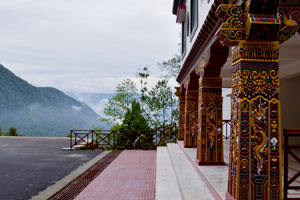Projects
New retreat centers in West Sikkim,India
With the increasing numbers of retreat students and limited space, We are exited to announce that H.H Rigzin Dorjee Rinpoche plans to build new retreat centers in West Sikkim to foster peace and tranquility in the world.
The name of the new retreat centers are as follows:
1.Kunchog Chidud Retreat Center,West Sikkim,India
2.Sera Khandro Retreat Center,West Sikkim,India
The Zhitro Mandala For Universal Peace
 This six story, 200 feet wide mandala will be built in the beautiful valley of Chuba, Sikkim, India. The unique contemporary design of this creation incorporates a community center, overnight guest suites, and a sacred inner chamber upon which the principle mandala resides. |  Mandala is a spiritual and ritual symbol in Hinduism and Buddhism, representing the Universe. |  Conceptual View of Zhitro Lhakhang at Chuba, South Sikkim |
In Tibetan Buddhism and Bön, Zhitro is the name of a genre of scripture and associated tantric practices primarily concerned with the “Hundred Peaceful and Wrathful Deities”. The best-known (though by no means only) example of this genre is “The Great Liberation by Hearing in the Intermediate State
A prominent sadhana, or practice text, is part of a group of bardo teachings which are held in the Nyingma tradition to have originated with Padmasambhava in the 8th century and were rediscovered as terma, or ‘treasure teachings’ in the 14th Century by the tertön Karma Lingpa. The Zhitro mandala teachings were found in the same terma collection as theBardo.
Thodol The Dzogchen practice of Zhitro involves viewing the body as a mandala of both peaceful and wrathful deities, the inclusivity promoting awareness in the practitioner of the universality of Buddha-nature. As a subtle body practice using yogic practices to manipulate the lung, or subtle-winds, of the body, this is a completion stage practice of the Inner Tantras. The Lion’s Roar Tantric Glossary describes the Zhitro mandala practice:
Zhi-khro is a practice of Tibetan Buddhism involving visualizing the body as a composite of the 108 peaceful and wrathful deities. In the practice, the deities are first visualized in mandalas of 58 peaceful and 42 wrathful deities centered in the heart, throat and crown chakra, and then in all the channels and nadis of the body.
The zhi-khro, which translates as the peaceful and wrathful deities, is considered part of the inner tantra. It is actually a condensed teaching based upon the essential meaning of the Guhyagarbha Tantra combined with the views expressed in the anu and ati yoga teachings. Many great masters have said that the zhi-khro teachings are the inner tantra of the inner tantra. In this case we’re not making distinctions among the various inner tantras, nor between the creation and completion stages, but joining them all together. This is the union of rigpa and emptiness, the oneness of birth, death, and life experiences. There is no basis for discriminating because all are aspects of one true nature. Nothing is rejected or exclusively accepted. This teaching is known as the one that unifies everything into a single state.
Construction of Hostel for Senior Monks in Nyingma Institute(Sherda)Martam,East Sikkim,India
Ongoing construction of Hostel for senior monks due to increased student enrollment and limited space
Nyingma Institute(Sherda)Martam,East Sikkim,India

H.H. Rigzin Dorjee Rinpoche offering puja on Newly Built Complex of Nyingma Institute Martam |

Front View of Nyingma Institute at Martam, East Sikkim |

Tradition pillar of Nyingma Institute at Martam,East Sikkim |
The Nyingma Institute (Sherda) is residential Institute to house of around 350 Monks, where they will study and practice
Higher Buddhist Studies and Philosophy. The course includes Philosophy, Literature, Metaphysics, Logic, Tantric
Studies, Ritual Prayers, Meditation Practices and English and is dedicated to providing a wholesome education. Its
education system encompasses the whole spectrum of education right up to the research level. A nine year course is
equivalent to an M.A. in students’ studies.
After completing the nine year course on these diverse subjects, students will receive an M.A in Philosophy. To obtain
PhD students may elect to complete three more years of research. After this, conferral of the higher degree of Khenpo
will be bestowed to candidates with outstanding personal qualities and teaching ability. The Nyingma Sherda’s purpose
is to spread Lord Buddha’s message of peace and non-violence in the world.